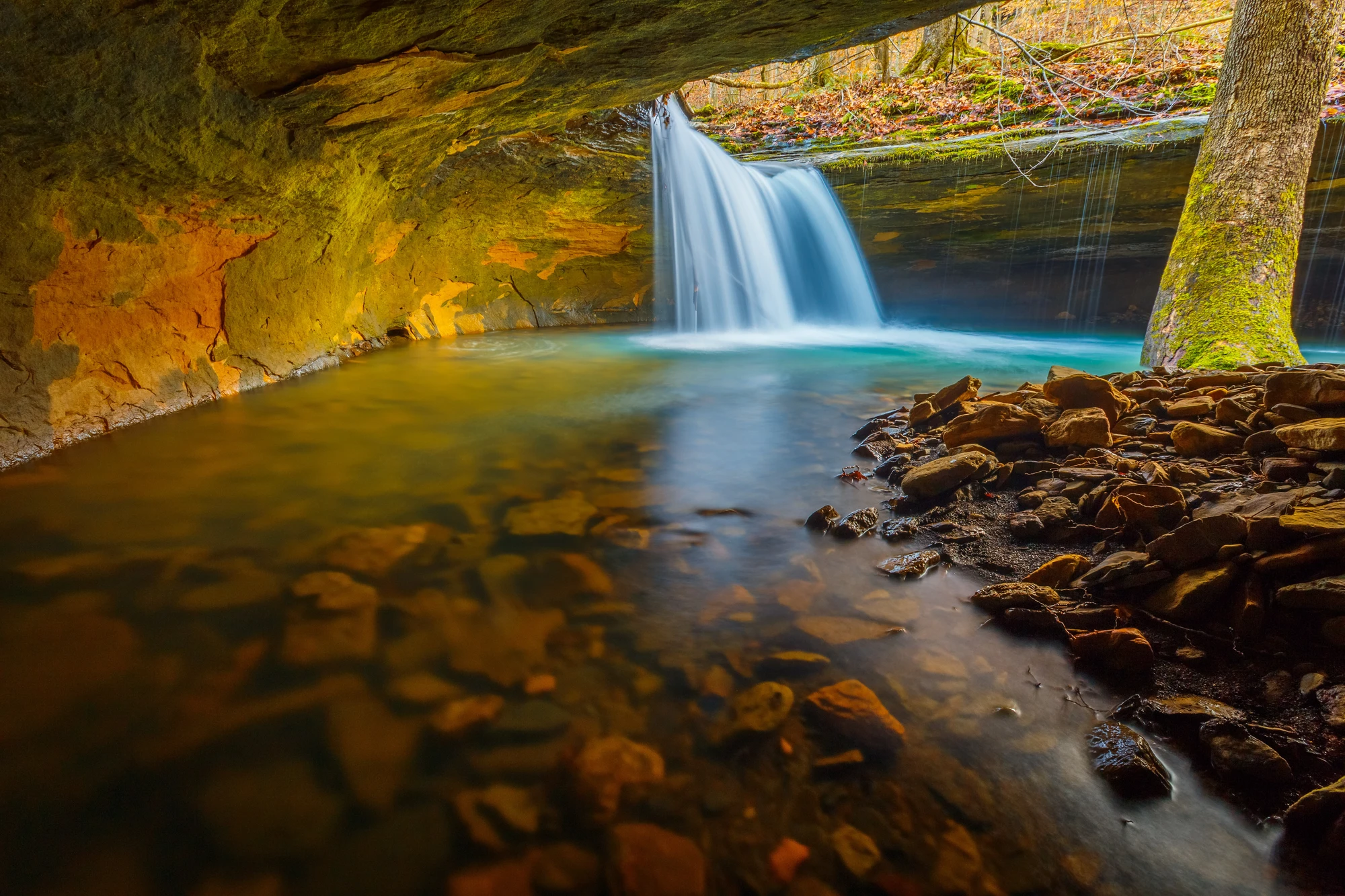Into the Quiet: Chasing a Hidden Waterfall in the Ozark National Forest
A quiet canyon, a short hike and a jaw-dropping cascade — discover Arkansas’s best-kept waterfall
Photo by Damon Shaw
Shutterstock (ID: 372210538)
The trail begins as a conversation with the forest: a soft rustle of oak leaves, a low, persistent hum of water somewhere below. You pick your way over limestone slabs slicked by moss, the path narrowing until trees close in and sunlight becomes a texture rather than a source. Then the sound sharpens into a presence — an edge of white against green. By the time the canyon opens, the waterfall has already declared itself, water spilling over a jagged lip and feathering into a shallow pool that glows pale jade. It’s the kind of place that rearranges your breathing.
Trail Wisdom
Pick early or late hours
Arrive at dawn or late afternoon to avoid crowds and to get the best light for photos.
Wear grippy footwear
Expect wet rock and loose gravel; hiking shoes with Vibram-like soles reduce slips.
Bring a small dry bag
Keep your camera and spare layers dry if you plan to sit near the spray or cross stream sections.
Stay on durable surfaces
Avoid creating new paths through moss and understory to protect sensitive riparian habitat.
Local Knowledge
Hidden Gems
- •Small upstream plunge pools that are perfect for a quiet rest
- •Rock overhangs and natural benches a few minutes from the main viewpoint that offer elevated perspectives
Wildlife
White-tailed deer, River otter
Conservation Note
The US Forest Service manages this landscape for multiple uses; practice Leave No Trace, camp on durable ground, and avoid disturbing riparian vegetation to protect water quality and habitat.
The Ozarks were historically used by Indigenous peoples and later supported logging and small-scale farming; the National Forest was established to conserve watersheds and manage timber resources sustainably.
Seasonal Guide
spring
Best for: Wildflowers and higher flows, Cooler air for longer hikes
Challenges: Muddy, slippery trails, Higher stream crossings after rain
Spring brings robust water flow and blooming understory, but expect muddy conditions and occasional hazardous crossings.
summer
Best for: Warm-weather swims, Longer daylight hours
Challenges: Heat and insects, Crowds on weekends
Summer is warm and lively; early starts help beat heat and bugs, and shade in the ravine offers respite.
fall
Best for: Peak foliage, Comfortable hiking temperatures
Challenges: Shorter daylight windows, Popular with leaf-watchers
Fall is ideal for color and comfortable conditions — plan for popular weekends and arrive early for solitude.
winter
Best for: Sparse crowds, Crisp, clear vistas
Challenges: Icy rock and cold water, Limited services in nearby towns
Winter offers quiet trails and stark beauty, but prepare for icy sections and dress in insulating layers.
Photographer's Notes
What to Bring
Supportive hiking shoes or light bootsEssential
Grippy soles and ankle support help on wet bedrock and rooty tread.
Light rain shellEssential
Protects against spray, sudden showers and wind in the canyon.
Water filter or purification tabletsEssential
Refills from streams after proper filtration keep packs light for longer outings.
Small travel tripod & ND filter
Stabilizes long exposures for smooth waterfall images in low light.
Common Questions
Do I need a permit to hike to the waterfall?
No special permit is required for day hiking in most parts of the Ozark National Forest, but check local trailhead signage and the US Forest Service website for any temporary closures or group limits.
Is swimming allowed at the pool below the falls?
Swimming is generally allowed where access is safe; use caution on slippery rock and avoid entering under the ledge where undercuts can create hazards.
Are dogs allowed on the trail?
Dogs are permitted on most forest trails but must be kept on leash per USFS rules in developed and parking areas; bring water and watch for ticks.
What's the best way to navigate to the trailhead?
Use a recent topo map or GPS track and target the nearest signed forest road; cell coverage is intermittent so download directions offline before you go.
When is the waterfall at its most dramatic?
After spring rains or following a steady run of showers, flows peak; otherwise late-winter and spring offer the most dramatic water volumes.
Is camping allowed nearby?
Dispersed camping is allowed in many sections of Ozark National Forest; choose durable surfaces, follow distance-from-water guidelines, and check for any seasonal restrictions.
What to Pack
Hiking boots for grip, water filter or 2L water for hydration, rain shell for canyon spray or sudden storms, headlamp if you’ll be returning near dusk
Did You Know
The Ozark National Forest encompasses roughly 1.2 million acres of public land in northwestern Arkansas, making it one of the largest contiguous forested areas in the region.
Quick Travel Tips
Arrive early to secure parking; download offline maps before leaving cell service; bring cash for rural businesses in nearby towns; check local weather for sudden storms
Local Flavor
Nearby towns like Russellville and Clarksville serve up Arkansas comfort food — think catfish, fried green tomatoes and slow-smoked barbecue — alongside small cafés and farm-to-table spots. Local music nights often feature bluegrass and old-time string bands that echo the region’s cultural roots.
Logistics Snapshot
Drive-in access via forest roads (some unpaved), free parking at trailhead, no kiosks or staffed rangers on-site most days, intermittent cell service, dispersed camping allowed with Leave No Trace practices.
Sustainability Note
Protect the fragile riparian zone by staying on trail, packing out all waste, using established campsites, and avoiding the removal of rocks or vegetation that stabilize the canyon.

